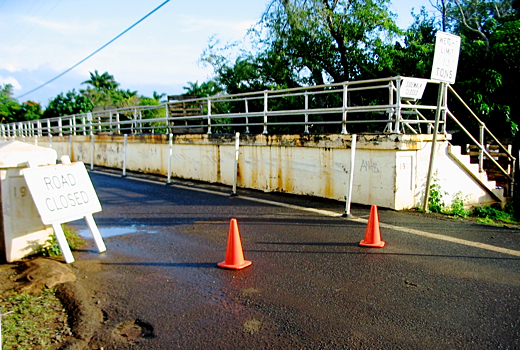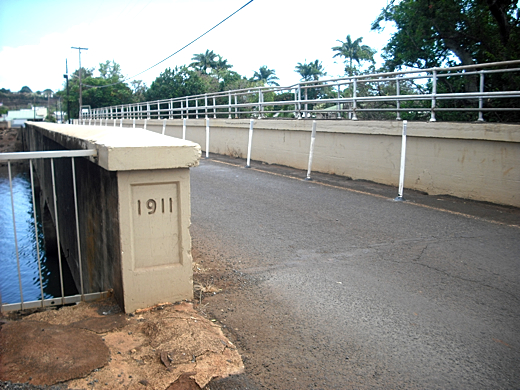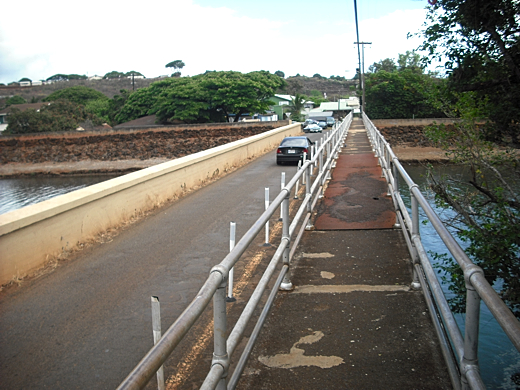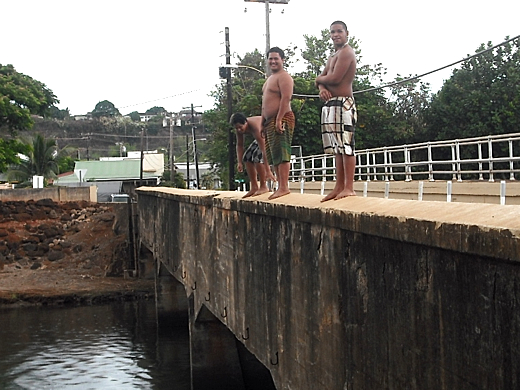SUBHEAD: County Council meeting Wednesday 11/19 to decide fate of historic bridge. Westsiders need to weigh in on this subject.
 Image above: The west approach to the Hanapepe 1911 Bridge showing it closure after storm is February 2008. Note stair leading up to walkway is at right. All photos by Juan Wilson.
By Juan Wilson on 17 October 2011 for Island Breath -
(http://islandbreath.blogspot.com/2011/10/fate-of-hanapepe-1911-bridge.html)
WHAT:
Image above: The west approach to the Hanapepe 1911 Bridge showing it closure after storm is February 2008. Note stair leading up to walkway is at right. All photos by Juan Wilson.
By Juan Wilson on 17 October 2011 for Island Breath -
(http://islandbreath.blogspot.com/2011/10/fate-of-hanapepe-1911-bridge.html)
WHAT:
County Council Meeting to discuss plan for repairing Hanapepe 1911 Bridge.
WHERE:
County Council Chambers
Historic County Building
4396 Rice Street, Suite 201
Lihue, Kauai, Hawai'i 96766
WHEN:
Wednesday, 19th October 2011 at approximately 1:30pm
 Image above: Photo 10/17/11 of West end of bridge after repainting for 100th birthday.
Image above: Photo 10/17/11 of West end of bridge after repainting for 100th birthday.
I've lived in Hanapepe Valley for a decade and use the 1911 Bridge over the Hanapepe River daily. I am an architect and planner and in my opinion the county has a bad plan to renovate the bridge. If implemented it will diminish the bridge's usefulness to the Westside community.
In 2007 an inspection of the 1911 Bridge revealed that the structural had several problems due to metal corrosion and concrete spalding. This included cracks in concrete and erosion of steel knee-braces that supported the raised pedestrian walkway on top of the south wall of the bridge.
Shortly afterwards the County put up barriers of wooden pallets and locked gates to restrict access to the walkway. They placed soft plastic bollards in a line to mark a walkway. This clumsy attempt to make the bridge less of a danger was certainly a result of some bean counters risk manager's calculations with help from the county attorney. These two steps have actually made the bridge more dangerous to the drivers and fishermen who use the bridge. But a least the County won't be sued successfully.
The County made proposals for fixing the bridge. They will make structural repairs, replace roadway and then provide a walkway. They presented three alternative plans for the walkway.
- Narrow the roadway to one lane and place a five-foot wide sidewalk along its south side.
- Built a new walkway at the roadway level outside the south wall of the bridge.
- Repair the existing walkway on top of the south wall of the bridge.
 Image above: Photo 10/17/11 of walkway used by fishermen and crabbers.
Image above: Photo 10/17/11 of walkway used by fishermen and crabbers.
Now the County has reduced its options to just Scheme #1 and wants to move ahead.
Scheme #1: Narrow Road, Relocate Walkway
The first scheme is the worst and cheapest. This solution proposes to provide ADA compliance for pedestrians on a five foot wide raised sidewalk. This is bit disingenuous. The approaches to the ADA compliant side walk are not ADA compliant. This effort would truly narrow the road to one lane.
The sidewalk would need reinforced bollards to protect pedestrians. This will reduce the car traffic lane to 13 feet. The bridge is often called "The One Lane Bridge", but the truth of the matter is the bridge has always accommodated two cars passing slowly. This has been a crucial when a driver gets onto the bridge roadway and an approaching driver does not heed the YIELD sign and enters the bridge. With its original width cars can pass one another carefully. That will not be true if the roadway is narrowed to 13 feet.
Four years ago soft plastic bollards were placed to provide a temporary walkway. Those that use the bridge frequently now that even this temporary narrowing of the road has made it more dangerous for drivers and fishermen.
Scheme #2: New Walkway next to Bridge
The second scheme would require extensive ramps on the east end to achieve its goal of allowing ADA approved handicapped access. This scheme would be hard to justify in the historic context of the bridge. It also is the most expensive scheme.
Scheme #3: Restore Existing Walkway
The last proposal is the only reasonable one. Before the 2007 inspection the walkway was used by crabbers and fishermen daily. They still do but have to stand in the narrow roadway, walk on the narrow to of the north bridge wall or climb up unto the barricaded walkway to fish and crab.
 Image above: Photo 10/17/11 of Kali family from Hanapepe Valley camping at 1911 Bridge.
Image above: Photo 10/17/11 of Kali family from Hanapepe Valley camping at 1911 Bridge.
Local people still bring cooler and folding chairs to the west end of the bridge and will spend a whole day relaxing and fishing with the family. Only restoring the existing walkway will maintain the cultural and historic use of the bridge as a recreational feature to the town.
Important to Westside
There is not doubt that the 100 year old concrete span across the Hanapepe River needs a major restoration. The County knows this and will spend quite a bit of money to restore the integrity of the bridge's structure and roadway. That's fine with everybody concerned.
Exactly how that is done is important not only to the residents of the town, but to surrounding community as well - especially people living on the west side of Hanapepe Valley and those living in Hanapepe Heights. It is also important to communities beyond on either side of the bridge who use Old Hanapepe Town and the recreational facilities at Salt Pond Beach Park. All together the bridge is used frequently by thousands of people.
Most people that don't live in these immediate communities stick to the main Kaumualii Highway 1938 bridge a quarter mile to the south. However, several times a year, for one reason or another, the main highway bridge will be shutdown and the 1911 Bridge is used by all highway traffic as the only alternative detour across the Hanapepe River.
Looking at the effort on the to accommodate recreational pedestrian traffic over the Wailua River and other points along the Eastside Bike Path, it would seem a reasonable thing to restore the existing walkway on 1911 Bridge for use of Westsiders. We're only talking about a four in concrete slab with railings and supported on steel knee-braces.
 Image above: Photo 10/17/11 of three local guys using bridge for recreational fun.
.
.
Image above: Photo 10/17/11 of three local guys using bridge for recreational fun.
.
.
 Image above: The west approach to the Hanapepe 1911 Bridge showing it closure after storm is February 2008. Note stair leading up to walkway is at right. All photos by Juan Wilson.
By Juan Wilson on 17 October 2011 for Island Breath -
(http://islandbreath.blogspot.com/2011/10/fate-of-hanapepe-1911-bridge.html)
WHAT:
County Council Meeting to discuss plan for repairing Hanapepe 1911 Bridge.
WHERE:
County Council Chambers
Historic County Building
4396 Rice Street, Suite 201
Lihue, Kauai, Hawai'i 96766
WHEN:
Wednesday, 19th October 2011 at approximately 1:30pm
Image above: The west approach to the Hanapepe 1911 Bridge showing it closure after storm is February 2008. Note stair leading up to walkway is at right. All photos by Juan Wilson.
By Juan Wilson on 17 October 2011 for Island Breath -
(http://islandbreath.blogspot.com/2011/10/fate-of-hanapepe-1911-bridge.html)
WHAT:
County Council Meeting to discuss plan for repairing Hanapepe 1911 Bridge.
WHERE:
County Council Chambers
Historic County Building
4396 Rice Street, Suite 201
Lihue, Kauai, Hawai'i 96766
WHEN:
Wednesday, 19th October 2011 at approximately 1:30pm
 Image above: Photo 10/17/11 of West end of bridge after repainting for 100th birthday.
I've lived in Hanapepe Valley for a decade and use the 1911 Bridge over the Hanapepe River daily. I am an architect and planner and in my opinion the county has a bad plan to renovate the bridge. If implemented it will diminish the bridge's usefulness to the Westside community.
In 2007 an inspection of the 1911 Bridge revealed that the structural had several problems due to metal corrosion and concrete spalding. This included cracks in concrete and erosion of steel knee-braces that supported the raised pedestrian walkway on top of the south wall of the bridge.
Shortly afterwards the County put up barriers of wooden pallets and locked gates to restrict access to the walkway. They placed soft plastic bollards in a line to mark a walkway. This clumsy attempt to make the bridge less of a danger was certainly a result of some bean counters risk manager's calculations with help from the county attorney. These two steps have actually made the bridge more dangerous to the drivers and fishermen who use the bridge. But a least the County won't be sued successfully.
The County made proposals for fixing the bridge. They will make structural repairs, replace roadway and then provide a walkway. They presented three alternative plans for the walkway.
Image above: Photo 10/17/11 of West end of bridge after repainting for 100th birthday.
I've lived in Hanapepe Valley for a decade and use the 1911 Bridge over the Hanapepe River daily. I am an architect and planner and in my opinion the county has a bad plan to renovate the bridge. If implemented it will diminish the bridge's usefulness to the Westside community.
In 2007 an inspection of the 1911 Bridge revealed that the structural had several problems due to metal corrosion and concrete spalding. This included cracks in concrete and erosion of steel knee-braces that supported the raised pedestrian walkway on top of the south wall of the bridge.
Shortly afterwards the County put up barriers of wooden pallets and locked gates to restrict access to the walkway. They placed soft plastic bollards in a line to mark a walkway. This clumsy attempt to make the bridge less of a danger was certainly a result of some bean counters risk manager's calculations with help from the county attorney. These two steps have actually made the bridge more dangerous to the drivers and fishermen who use the bridge. But a least the County won't be sued successfully.
The County made proposals for fixing the bridge. They will make structural repairs, replace roadway and then provide a walkway. They presented three alternative plans for the walkway.
 Image above: Photo 10/17/11 of walkway used by fishermen and crabbers.
Now the County has reduced its options to just Scheme #1 and wants to move ahead.
Scheme #1: Narrow Road, Relocate Walkway
The first scheme is the worst and cheapest. This solution proposes to provide ADA compliance for pedestrians on a five foot wide raised sidewalk. This is bit disingenuous. The approaches to the ADA compliant side walk are not ADA compliant. This effort would truly narrow the road to one lane.
The sidewalk would need reinforced bollards to protect pedestrians. This will reduce the car traffic lane to 13 feet. The bridge is often called "The One Lane Bridge", but the truth of the matter is the bridge has always accommodated two cars passing slowly. This has been a crucial when a driver gets onto the bridge roadway and an approaching driver does not heed the YIELD sign and enters the bridge. With its original width cars can pass one another carefully. That will not be true if the roadway is narrowed to 13 feet.
Four years ago soft plastic bollards were placed to provide a temporary walkway. Those that use the bridge frequently now that even this temporary narrowing of the road has made it more dangerous for drivers and fishermen.
Scheme #2: New Walkway next to Bridge
The second scheme would require extensive ramps on the east end to achieve its goal of allowing ADA approved handicapped access. This scheme would be hard to justify in the historic context of the bridge. It also is the most expensive scheme.
Scheme #3: Restore Existing Walkway
The last proposal is the only reasonable one. Before the 2007 inspection the walkway was used by crabbers and fishermen daily. They still do but have to stand in the narrow roadway, walk on the narrow to of the north bridge wall or climb up unto the barricaded walkway to fish and crab.
Image above: Photo 10/17/11 of walkway used by fishermen and crabbers.
Now the County has reduced its options to just Scheme #1 and wants to move ahead.
Scheme #1: Narrow Road, Relocate Walkway
The first scheme is the worst and cheapest. This solution proposes to provide ADA compliance for pedestrians on a five foot wide raised sidewalk. This is bit disingenuous. The approaches to the ADA compliant side walk are not ADA compliant. This effort would truly narrow the road to one lane.
The sidewalk would need reinforced bollards to protect pedestrians. This will reduce the car traffic lane to 13 feet. The bridge is often called "The One Lane Bridge", but the truth of the matter is the bridge has always accommodated two cars passing slowly. This has been a crucial when a driver gets onto the bridge roadway and an approaching driver does not heed the YIELD sign and enters the bridge. With its original width cars can pass one another carefully. That will not be true if the roadway is narrowed to 13 feet.
Four years ago soft plastic bollards were placed to provide a temporary walkway. Those that use the bridge frequently now that even this temporary narrowing of the road has made it more dangerous for drivers and fishermen.
Scheme #2: New Walkway next to Bridge
The second scheme would require extensive ramps on the east end to achieve its goal of allowing ADA approved handicapped access. This scheme would be hard to justify in the historic context of the bridge. It also is the most expensive scheme.
Scheme #3: Restore Existing Walkway
The last proposal is the only reasonable one. Before the 2007 inspection the walkway was used by crabbers and fishermen daily. They still do but have to stand in the narrow roadway, walk on the narrow to of the north bridge wall or climb up unto the barricaded walkway to fish and crab.
 Image above: Photo 10/17/11 of Kali family from Hanapepe Valley camping at 1911 Bridge.
Local people still bring cooler and folding chairs to the west end of the bridge and will spend a whole day relaxing and fishing with the family. Only restoring the existing walkway will maintain the cultural and historic use of the bridge as a recreational feature to the town.
Important to Westside
There is not doubt that the 100 year old concrete span across the Hanapepe River needs a major restoration. The County knows this and will spend quite a bit of money to restore the integrity of the bridge's structure and roadway. That's fine with everybody concerned.
Exactly how that is done is important not only to the residents of the town, but to surrounding community as well - especially people living on the west side of Hanapepe Valley and those living in Hanapepe Heights. It is also important to communities beyond on either side of the bridge who use Old Hanapepe Town and the recreational facilities at Salt Pond Beach Park. All together the bridge is used frequently by thousands of people.
Most people that don't live in these immediate communities stick to the main Kaumualii Highway 1938 bridge a quarter mile to the south. However, several times a year, for one reason or another, the main highway bridge will be shutdown and the 1911 Bridge is used by all highway traffic as the only alternative detour across the Hanapepe River.
Looking at the effort on the to accommodate recreational pedestrian traffic over the Wailua River and other points along the Eastside Bike Path, it would seem a reasonable thing to restore the existing walkway on 1911 Bridge for use of Westsiders. We're only talking about a four in concrete slab with railings and supported on steel knee-braces.
Image above: Photo 10/17/11 of Kali family from Hanapepe Valley camping at 1911 Bridge.
Local people still bring cooler and folding chairs to the west end of the bridge and will spend a whole day relaxing and fishing with the family. Only restoring the existing walkway will maintain the cultural and historic use of the bridge as a recreational feature to the town.
Important to Westside
There is not doubt that the 100 year old concrete span across the Hanapepe River needs a major restoration. The County knows this and will spend quite a bit of money to restore the integrity of the bridge's structure and roadway. That's fine with everybody concerned.
Exactly how that is done is important not only to the residents of the town, but to surrounding community as well - especially people living on the west side of Hanapepe Valley and those living in Hanapepe Heights. It is also important to communities beyond on either side of the bridge who use Old Hanapepe Town and the recreational facilities at Salt Pond Beach Park. All together the bridge is used frequently by thousands of people.
Most people that don't live in these immediate communities stick to the main Kaumualii Highway 1938 bridge a quarter mile to the south. However, several times a year, for one reason or another, the main highway bridge will be shutdown and the 1911 Bridge is used by all highway traffic as the only alternative detour across the Hanapepe River.
Looking at the effort on the to accommodate recreational pedestrian traffic over the Wailua River and other points along the Eastside Bike Path, it would seem a reasonable thing to restore the existing walkway on 1911 Bridge for use of Westsiders. We're only talking about a four in concrete slab with railings and supported on steel knee-braces.
 Image above: Photo 10/17/11 of three local guys using bridge for recreational fun.
.
.
Image above: Photo 10/17/11 of three local guys using bridge for recreational fun.
.
.
No comments :
Post a Comment